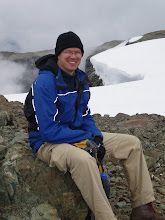In the popular media of recent months I've noticed some similar experiences. Sandra Oh states, "No matter how much you fit in, you're the outsider, and you only realize much later how deeply the assimilation affects you. You always feel like you miss out just a little bit. You are just not the same" (Onstad, K. "Oh la la," Chatelaine November 2007, 120). Wyclef Jean states, "I feel that I am part of the American Dream but I feel that for you to have the American Dream you need to have that immigrant background, meaning that at the end of the day we all are immigrants so we should still be treated with respect" (The Hour, October 30, 2007). Perhaps, the most extreme case of cultural dislocation is that of the American soldier in Iraq, who in the course of 48 hours moves from the front-lines to the couch at home; he then returns after a two week visit, a trip that includes moving through various paradigms, e.g., camaraderie vs. family integration, friend/foe vs. loved ones, alertness vs. relaxation, and duty vs. expectation.
My identity has been shaped by various factors over the years and has taken the form of many personal narratives, e.g., the traveler, the student, the independent. However, the obscure nature of Canadian identity has hampered my journey, i.e., establishing what is uniquely Canadian is a difficult task. Thus, my journey has included establishing what being a Canadian is. I have done so by learning the history, listening to its great musicians, reading its literature, and talking with many of its citizens. Nevertheless one can only do so much, but I have noticed a few things. First, many are looking for definition. It is a frequent topic that has spurned many debates and Molson TV commercials. Second, regional variation has muddled the issue. I once entertained one way of commenting on this diversity, as well as obtaining my 15 minutes of fame, but the threat of jail-time dissuaded me: during an election in rural B.C., I would post election signs for a fake candidate that was running for the Parti Québécois. The reactions would not have been pretty.
In the last ten years on the west coast (I can only comment from this perspective, though I live vicariously in the east coast through the music of Stan Rogers), native art has become a significant expression of our culture. It has dominated all new public buildings and I can't complain, e.g., Bill Reid's Jade Canoe is amazing. Nevertheless, I wonder what it is replacing. What would be the Olympic symbol if this weren't the trend? A lumberjack, a miner? Yes, pre-90's the west coast was defined by its dependence on natural resources. For some reason the Pacific Rim connection never took a firm hold on the coast despite a number of sister cities and Japanese immersion programs. Then came the wave of First Nation's art. At first I found this choice ironic, since there have been so very few treaties negotiated (Tsawwassen this year was only the second). Then, I realized that this art grounded us. It is an art that transcends the lumberjacks and real estate developers from Hong Kong; furthermore, by transcending the modern, it complements, rather than clashes with, the rich cultural diversity of the west coast. Its modern interpretation provides the sophistication needed for cultural cache in larger cities. Lastly, the art was authentic: it was part of a flourishing prompted by the return of many First Nations to their roots.
Among First Nations is one place that I have always belonged in Canada, though my white skin obviously betrays me as an outsider. Learning the history of the land has grounded me and provided meaning for me. Certain sites and landscapes take on new meaning for me as I learn the place name and its meaning in the original language. This experience has also made me more Canadian: I can't tell you the number of times I passed by the Quw'utsun' Cultural Centre, but this summer I finally visited it and was really impressed. The dancers, carvers and interpretive guides provided a rich experience among amazing displays and relics that was topped off by an amazing meal at the Riverwalk Cafe (the Bistro at Cherry Point also owned by the Cowichan Tribes is very good also).
Another source of richness in my Canadian education has been the CBC, especially radio: Peter Gzowski put me in touch with the personal, quirky and interesting; Michael Enwright with the sophisticated; Stuart McLean with the funny, but more so with a rich appreciation through his poetic descriptions of Canada; and Sheila Rogers with diverse, but everyday Canadians and issues. Then there's As It Happens that uniquely Canadian show and thanks to them I listen to Alan Maitland read The Shepherd every Christmas.
In the end the diverse nature of Canada does not make it indefinable, rather it's part and parcel to the process. Culture, though diverse, does provide the social norms by which Canadians can define themselves.



No comments:
Post a Comment